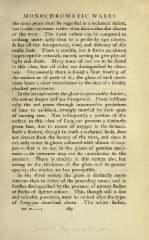Page 359 - Oriental Series Japan and China, Brinkly
P. 359
MONOCHROMATIC WARES
the same piece must be regarded as a technical defect,
but it often increases rather than diminishes the charm
of the ware. The finest colour can be compared to
nothing more aptly than to a perfectly ripe cherry.
It has all the transparency, eclat and delicacy of the
y
ruddy fruit. There is crackle, but it forms an almost
imperceptible network, merely serving to give play of
light and shade. Many tones of red are to be found
in this class, but all alike are distinguished by clear-
ness. Occasionally there is found a faint frosting of
the surface or of parts of it the glaze of such speci-
;
mens bears a close resemblance to the skin of a freshly
plucked persimmon.
In the second variety the glaze is appreciably thicker;
the colour deeper and less transparent. From brilliant
ruby the red passes through innumerable gradations
of tone to ox-blood, strongly mottled by dark spots
of varying size. Not infrequently a portion of the
surface in this class of Lang-yao presents a distinctly
green hue, due to excess of oxygen in the furnace.
Such a feature, though in truth a technical fault, does
not detract from the beauty of the ware, and since it
can only occur in glazes coloured with silicate of cop-
per that is to say, in the glazes of genuine speci-
mens its presence may not be unwelcome to the
amateur. There is crackle in this variety also, but
owing to the thickness of the glaze and its greater
opacity, the meshes are less perceptible.
In the third variety the glaze is distinctly more
vitreous than in either of the preceding cases ; and is
further distinguished by the presence of minute flashes
or flecks of lighter colour. This, though still a fine
and valuable porcelain, must be ranked after the types
of Lang-yao described above. The white flashes,
VOL. IX. 19 289

